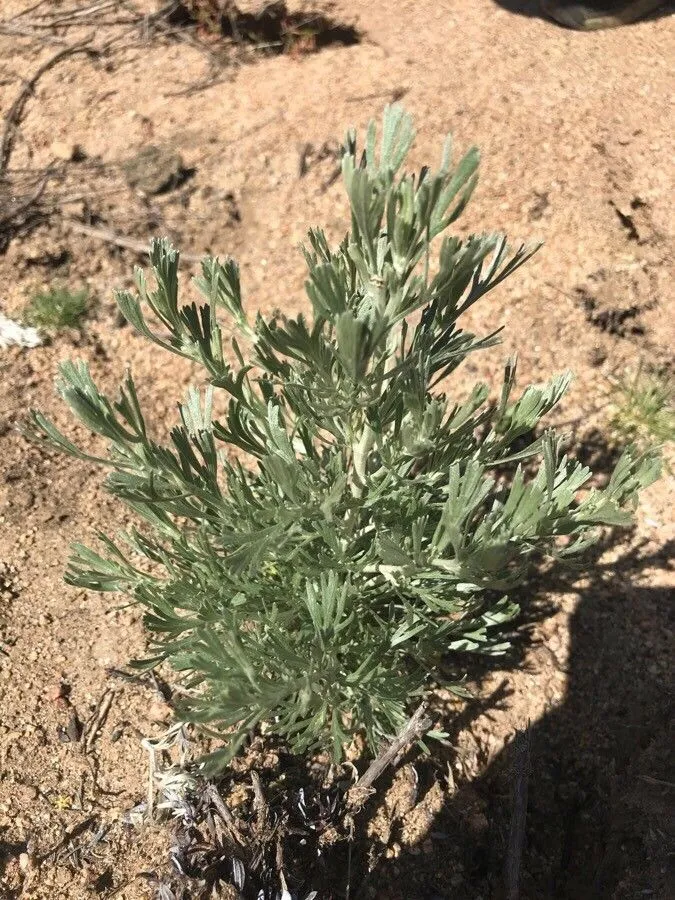
Author: Nutt.
Bibliography: Trans. Amer. Philos. Soc., ser. 2, 7: 398 (1841)
Year: 1841
Status: accepted
Rank: species
Genus: Artemisia
Vegetable: False
Observations: W. Canada to Mexico (Baja California Norte)
Basin sagebrush, known scientifically as Artemisia tridentata, is a significant and characteristic plant belonging to the Asteraceae family. This hardy shrub is widely recognized for its resilience and adaptability, thriving across a vast range from western Canada down to Baja California Norte in Mexico.
First formally described in 1841 by the botanist Thomas Nuttall, as recorded in the Transactions of the American Philosophical Society, Artemisia tridentata holds a crucial place in its ecosystems. The plant is easily identified by its distinctive three-lobed leaves, from which it derives its scientific name. These leaves are typically grey-green and covered with fine hairs, which help to reduce water loss—a vital adaptation for survival in the often arid and harsh environments it inhabits.
Basin sagebrush typically reaches heights of 1 to 3 meters, presenting a sprawling and rounded form. During late summer, it produces small, clustered flowers that are yellow and somewhat inconspicuous, yet play a critical role in the reproduction of the species. The flowers transform into small seeds that spread through the wind, facilitating the plant’s wide distribution across diverse terrains.
Ecologically, Artemisia tridentata is invaluable. It provides food and habitat for a plethora of wildlife, including insects, birds, and mammals. For instance, it offers essential winter forage for wildlife such as mule deer and sage grouse. Additionally, its deep-rooted systems help prevent soil erosion and maintain soil structure, playing a protective role in the landscape.
Culturally, basin sagebrush has been utilized by Native American tribes for various purposes. Its leaves and stems have been used in traditional medicine, while the aromatic qualities of the plant have brought it historical significance for its use in rituals and as a spice.
This sagebrush species is not only a resilient and dynamic part of its natural habitat but also an important plant for biodiversity, traditional practices, and soil conservation. It exemplifies the intricate connections within ecosystems and highlights the adaptive strategies plants evolve to thrive in diverse and challenging environments.
En: Basin sagebrush, Sagebrush, Big sagebrush, Common sagebrush, Bonneville big sagebrush, Big sagebush, Big sage
Fr: Armoise tridentée
De: Dreizähniger Wermut
© copyright of the Board of Trustees of the Royal Botanic Gardens, Kew.
Taken Jun 1, 2018 by Daniel Barthelemy (cc-by-nc)
Taken Jun 1, 2018 by Daniel Barthelemy (cc-by-nc)
Taken Jun 1, 2018 by Daniel Barthelemy (cc-by-nc)
Taken Nov 15, 2021 by Taylor Shook (cc-by-sa)
Taken Nov 15, 2021 by Taylor Shook (cc-by-sa)
Taken Mar 20, 2022 by bibopalula (cc-by-sa)
Taken Sep 13, 2019 by Matthieu Ravera (cc-by-sa)
Taken Dec 12, 2019 by Brianna brianna (cc-by-sa)
Taken Jun 18, 2019 by kalani kalani (cc-by-sa)
Taken Jul 14, 2019 by
Taken Nov 15, 2021 by Taylor Shook (cc-by-sa)
Taken Jan 29, 2022 by Mel Mun (cc-by-sa)
Taken Feb 23, 2016 by EOL − K Schneider (cc-by-nc)
Taken May 29, 2013 by EOL − BJ Stacey (cc-by-nc)
Taken Oct 28, 2020 by Terri Buttleman (cc-by-sa)
Taken Nov 15, 2021 by Taylor Shook (cc-by-sa)
Taken Jul 27, 2020 by Manon dewaele (cc-by-sa)
Taken Jun 14, 2013 by EOL − BJ Stacey (cc-by-nc)
Taken Apr 30, 2015 by EOL − Steve Matson (cc-by-nc)
Taken Apr 21, 2022 by Liz Pucket (cc-by-sa)
Taken May 23, 2020 by Dmitry Teytelman (cc-by-sa)
Taken Nov 24, 2019 by Dane Rob (cc-by-sa)
Taken Jul 4, 2021 by Kat (cc-by-sa)
Taken Jun 6, 2013 by EOL − BJ Stacey (cc-by-nc)
Taken Mar 21, 2016 by EOL − James Bailey (cc-by-nc)
Taken Aug 4, 2005 by EOL − Steven J. Baskauf (cc-by-nc-sa)
Taken Nov 24, 2019 by Dane Rob (cc-by-sa)
Taken Sep 8, 2021 by n clark (cc-by-sa)
Growth form>: Multiple Stem
Growth habit>: Tree, Shrub
Growth rate>: Slow
Ph maximum: 8.2
Ph minimum: 6.0
Family: Myrtaceae Author: (F.Muell.) K.D.Hill & L.A.S.Johnson Bibliography: Telopea 6: 402 (1995) Year: 1995 Status:…
Family: Rubiaceae Author: Pierre ex A.Froehner Bibliography: Notizbl. Bot. Gart. Berlin-Dahlem 1: 237 (1897) Year:…
Family: Sapindaceae Author: Koidz. Bibliography: J. Coll. Sci. Imp. Univ. Tokyo 32(1): 38 (1911) Year:…
Family: Asteraceae Author: A.Gray Bibliography: Pacif. Railr. Rep.: 107 (1857) Year: 1857 Status: accepted Rank:…
Family: Fabaceae Author: Medik. Bibliography: Vorles. Churpfälz. Phys.-Ökon. Ges. 2: 398 (1787) Year: 1787 Status:…
Family: Aspleniaceae Author: (Cav.) Alston Bibliography: Bull. Misc. Inform. Kew 1932: 309 (1932) Year: 1932…